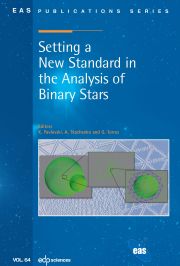No CrossRef data available.
Article contents
Towards a coherent view at infrared wavelengths of mass loss in Betelgeuse
Published online by Cambridge University Press: 23 May 2013
Abstract
The violent convective motions, low surface gravity, and high brightness of red supergiants combine to trigger an intense stellar wind. As the distance from the star increases, the standard scenario is that the ejected material forms molecules, then dust particles. But this general picture is still fragmentary. Our goal is to assemble a better understanding of mass loss in Betelgeuse, considered as a prototype for its class, from its photosphere to the interface of its wind with the interstellar medium. Thanks to its proximity ( ≈ 197 pc), it is ideally suited for such a detailed study. Over the past few years, our team obtained an extensive set of observations of Betelgeuse from high angular resolution instruments, probing a broad range of spatial scales: 1) interferometric imaging of its photosphere and close envelope in the near- and thermal-IR domains (IOTA/IONIC), 2) adaptive optics “lucky imaging” of its compact molecular envelope (VLT/NACO, 1.0–2.2 μm), and 3) diffraction-limited imaging of its dusty envelope (VLT/VISIR, 8–20 μm). From our interferometric data, we detect the presence of spots at the surface of the star, as well as CO and H2O molecules, and dust particles close to the star. Within 6 R⋆, the flux distribution of the envelope is compatible with the presence of the CN molecule. At a few arcseconds from the central star, we observe a complex dusty envelope probably containing O-rich dust (e.g. silicates, alumina). We present an overview of these recent observational results and ongoing work. They provide new hints on the physical and chemical mechanisms through which Betelgeuse interacts with its environment.
- Type
- Research Article
- Information
- Copyright
- © EAS, EDP Sciences 2013


